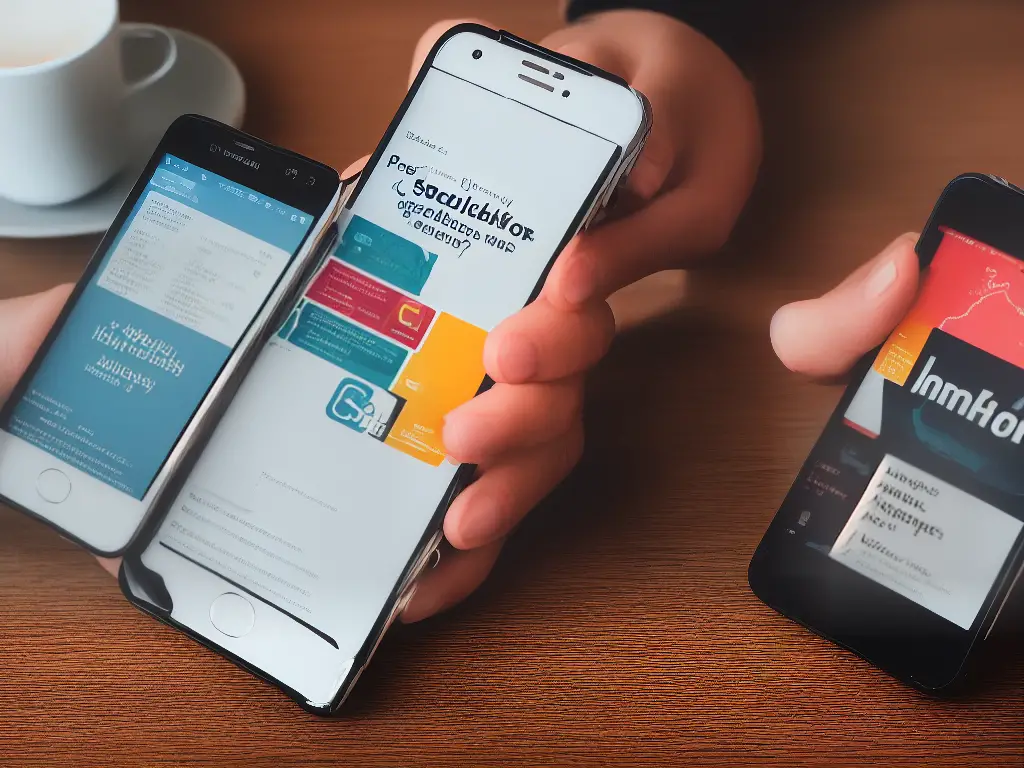In the era of rapidly evolving digital landscape, businesses are constantly seeking effective marketing strategies to reach their target audience, increase brand visibility and drive sales. Two such powerful marketing approaches are influencer marketing and digital publishing, each boasting distinct characteristics, strategies, and outcomes. This analysis delves into the core fundamentals of both influencer marketing and digital publishing, along with outlining their respective pros, cons, and real-life success stories, thereby providing an insightful understanding of these contemporary tactics to help businesses make informed decisions on their marketing endeavors.
Influencer Marketing Basics
Influencer marketing has taken the world of digital advertising by storm. At its core, this form of marketing leverages the power of social media personalities to endorse and promote products or services to their followers. Influencers, as they are called, amass large followings on platforms such as Instagram, YouTube, Twitter, and TikTok, making them highly sought after by brands looking to tap into specific target markets. Unlike traditional digital publishing, which consists of creating and distributing content on digital platforms like websites or online magazines, influencer marketing banks on the personal relationships that influencers cultivate with their audience.
Influencers come in various types, such as mega-influencers, macro-influencers, micro-influencers, and nano-influencers. Each group differs in the size of their follower base, with mega-influencers boasting millions of followers and nano-influencers having less than 10,000. Brands typically work with influencers who cater to a specific niche relevant to their target market. For instance, if a fitness brand is looking to promote its activewear line, it could partner with a fitness-focused influencer to reach out to an audience interested in exercise and wellness.
Another essential aspect of influencer marketing is engagement. Unlike digital publishing, where users mainly consume content passively, influencers encourage active participation from their followers. This interaction can take the form of likes, comments, shares, or even direct feedback. High engagement rates indicate a strong connection between the influencer and their audience; this fosters trust and authenticity, two elements that can directly impact audience conversion and purchasing decisions.
Influencer marketing relies heavily on content creation. Unlike digital publishing, which may involve journalists or authors to create text-based articles or stories, influencers generate various content formats, often incorporating pictures or videos to provide a more immersive experience to their audience. They are known for their creative and unique methods to integrate marketing messages seamlessly into their content, whether through product reviews, tutorials, or sponsored posts, making it more appealing for their followers without seeming overly promotional.
Influencer marketing and digital publishing are two contemporary approaches to promoting content and reaching large audiences in the digital era. Influencer marketing leverages the appeal and reach of popular individuals to promote a message or a product, while digital publishing involves the production and distribution of various types of content, such as articles, ebooks, videos, and podcasts, using digital channels like online magazines, blogs, and social media platforms.

Digital Publishing Basics
One significant advantage of influencer marketing over digital publishing is the diversified approach of using multiple social media channels. Unlike digital publishing that mostly focuses on websites, online magazines or blogs, influencers operate across different platforms, allowing them to reach a broader audience and maintain a sense of relatability among their followers. Each platform caters to unique characteristics or content types, such as short-form videos for TikTok, images for Instagram, or long-form content for YouTube. Brands can leverage this flexibility in their influencer marketing campaigns to optimize their reach and engagement across various platforms, creating a strong and effective strategy compared to traditional digital publishing methods.
Influencer marketing, on the other hand, is a form of marketing that focuses on using key individuals, often with a sizable and engaged following, to drive a brand’s message and promote products or services. This type of marketing capitalizes on the trust and credibility these influencers have with their audience to generate interest and sales. Some examples of platforms commonly used in influencer marketing are Instagram, YouTube, and TikTok.
Digital publishing and influencer marketing share some similarities, as both utilize digital platforms and content creation to reach their target audiences. The significant difference lies in the purpose of the content produced. Digital publishers typically focus on providing informative or entertaining content for a broader audience, who may not have a pre-existing relationship with them. On the other hand, influencer marketing relies on the personal connections and trust between an influencer and their followers, using that established credibility to promote products or services.
Revenue models in digital publishing and influencer marketing vary depending on the platform and the type of content produced. For digital publishers, typical revenue streams include advertising (such as banner ads, sponsored content, or affiliate marketing), sales of digital products or services (such as ebooks or online courses), and subscription-based access to premium content. Influencer marketing, on the other hand, usually involves deals or collaborations between brands and influencers, where the latter is compensated through monetary payment, gifts, or commissions based on the number of sales generated through their promotion efforts.
In the ever-evolving digital landscape, both digital publishing and influencer marketing are continuously growing and adapting to the changing demands and preferences of users. It is crucial for businesses and creators looking to leverage these strategies to remain agile and open to new methods of reaching their target audience. The most successful approach will ultimately depend on the specific goals of the organization, the type of content being produced, and the platforms used for distribution.

Influencer Marketing Strategy
One approach, influencer marketing, is a relatively new and expanding avenue that allows brands to directly promote and advertise their products or services to their target audience. Differing from traditional digital publishing, influencer marketing taps into the pool of social media influencers who have already carved out a niche for themselves and boast a loyal follower base. These influencers act as indirect mediums by promoting or endorsing a brand, thus encouraging their followers to use or purchase the advertised product, creating a synergy between the two strategies and maximizing their potential impact.
To create an effective influencer marketing strategy, brands need to start by setting clear goals and objectives. Defining quantifiable metrics like the number of sales, leads, or conversions generated will enable brands to gauge the effectiveness of their campaigns. Additionally, brands should ascertain their target audience, and identify the most relevant and valuable influencers to partner with. This enables brands to increase engagement and trust among their target audience, thereby boosting their advertising returns.
One of the most vital steps in crafting an influencer marketing strategy is to find the right influencers who can successfully represent a brand’s identity and values. First, businesses should consider factors such as the influencers’ niche, audience demographics, and overall online reputation. Utilizing social media monitoring tools, brands can also identify potential influencers who are actively engaging with audiences and producing appealing content that resonates with their target market.
In contrast to digital publishing, which involves placing ads on websites, blogs, or social media without influence from content creators, influencer marketing allows for a more authentic and human-centered approach to delivering promotional messages. When influencers genuinely believe in a product or have previously used it, it has a more significant impact on their followers. As a result, there is better brand recall and connection, which can lead to higher conversion rates compared to traditional digital ads.
In the world of digital marketing, two popular and effective strategies are digital publishing and influencer marketing. Digital publishing strategy involves creating and optimizing content like articles, e-books, and whitepapers, and monetizing them through various advertising opportunities. This approach focuses on producing valuable content that draws readers in and builds brand loyalty over time.

Digital Publishing Strategy
On the other hand, influencer marketing is a tactic where brands partner with influencers who already have a strong following on social media platforms to promote their products or services. To measure the success of an influencer marketing campaign, businesses need to employ a mix of quantitative and qualitative analytics, including tracking the number of clicks, impressions, conversions, ROI, and overall brand sentiment generated through influencer partnerships. Analyzing these metrics allows brands to assess the effectiveness of their influencer marketing campaigns and adjust their strategies to optimize the engagement rates, acquisition costs, and the quality of promotion. Comparing the outcomes of influencer marketing with digital publishing campaigns can help brands determine which channel best suits their marketing objectives and audience preferences.
In order to create a profitable digital publishing strategy, it’s essential to focus on promoting your content to your target audience through various channels. This can include social media platforms, email marketing, and search engine marketing. When promoting content, it’s essential to use varying formats, like images, infographics, and videos to cater to different audiences and their preferences.
Simultaneously, influencer marketing leverages the power of individuals who have established their expertise, trust, and credibility within their niche. By partnering with such influencers, brands can reach their target audience more effectively and authentically.
Search engine optimization (SEO) is a crucial aspect of any successful digital publishing strategy. It helps improve the visibility of your content on search engine results pages, making it easier for your target audience to find you. A solid SEO strategy involves optimizing the content for relevant keywords, ensuring the website is mobile-friendly, and building a network of backlinks from reputable sources.
Comparatively, influencer marketing doesn’t directly contribute to SEO, but the buzz created by influencers might result in others linking to your content or website, thereby indirectly improving your SEO status.
Maximizing advertising opportunities is necessary for an effective digital publishing strategy. There are several methods to monetize content, such as display ads, sponsored content, and affiliate marketing. By including these revenue-generating techniques, brands can create a steady stream of income from their digital publications.
On the other hand, influencer marketing can boost the performance of brand advertising campaigns by leveraging the personal connections of influencers. This can lead to increased visibility, engagement, and ultimately, revenue.
Both digital publishing strategies and influencer marketing have their unique advantages in promoting a brand’s digital marketing plan. Knowing when and how to leverage each approach can help brands achieve their objectives, reach their target audience, and build long-lasting relationships. Understanding these methods’ similarities and differences can help brands choose the right mix for their overall marketing strategies.

The Pros and Cons of Influencer Marketing
Influencer marketing, for instance, has emerged as an effective way for brands to reach specific demographics in the digital space. By partnering with influencers who have a large following in the target market, brands can share focused, relevant content, engaging a responsive audience authentically. On the other hand, digital publishing often involves placing ads on websites, blogs, or social media platforms without a guarantee of reaching a genuinely interested audience. However, by creating engaging content, optimizing for search engines, and maximizing advertising opportunities, both publishing and influencers can contribute to improving brand awareness and increasing sales.
Cost is another factor that comes into play when comparing influencer marketing to digital publishing. While it may initially seem expensive to partner with high-profile influencers, the return on investment (ROI) can be significantly higher as compared to other digital marketing approaches. The targeted nature of influencer marketing campaigns ensures that the promotion of the product lines up with the target audience smoothly, resulting in higher engagement rates and conversions. On the other hand, the costs associated with digital publishing largely depend on the nature of the ad platform, targeting options, and the size of the intended audience.
Influencer marketing, however, does come with a set of risks as well. One potential disadvantage is the dependency on the influencer’s reputation and audience engagement. If the influencer’s popularity decreases or the audience loses interest, the effectiveness of the marketing campaign will suffer accordingly. Moreover, maintaining control over the brand image can be challenging when dealing with multiple influencers, as the messaging and tone can vary drastically depending on the influencer’s style.
Another potential downside of influencer marketing is the possible negative impact of controversies or scandals associated with influencers. If an influencer’s reputation takes a hit due to such incidents, the brand’s image can also suffer as a result. Such risks are absent in digital publishing, where the marketing materials are created and controlled solely by the brand itself without depending on a third-party figure.
In conclusion, both influencer marketing and digital publishing have their respective advantages and disadvantages. Influencer marketing can help businesses tap into specific target markets, generate higher audience engagement, and potentially achieve better ROI. However, the risks associated with leveraging influencers’ reputation and maintaining brand consistency cannot be ignored. On the other hand, digital publishing provides a more controlled advertising environment but may struggle to create the same level of authenticity and connection that influencer marketing can offer. Ultimately, businesses need to evaluate their target audience and resources to determine which marketing approach suits their needs best.

The Pros and Cons of Digital Publishing
One aspect that sets digital publishing apart from influencer marketing is its immense global reach. Digital publishing platforms allow content creators to easily distribute their work to an international audience, expanding their potential customer base and increasing their chances of gaining new followers and readers. In contrast, influencer marketing largely depends on an individual’s network, with its audience reach being limited to the number of followers the influencer has. While influencers may have a diverse range of followers, their reach is not guaranteed to be as widespread as that of digital publishing platforms. As such, businesses should carefully consider these factors when deciding which marketing strategy to employ.
Moreover, digital publishing has significantly lower overhead costs compared to influencer marketing. Publishing content online in a digital format allows creators to eliminate expenses such as printing, warehousing, and distribution that are typically associated with traditional print publishing. Furthermore, digital publishing provides the opportunity to make periodic updates to content, catering to ever-evolving audience needs. Conversely, influencer marketing often involves heavy expenses, as companies need to pay fees or offer free products and services to influencers in exchange for promoting their brand or products.
However, digital publishing does come with its limitations. The digital landscape tends to be highly saturated with content, making it difficult for creators to stand out from the crowd and gain traction among potential readers. With influencer marketing, a degree of credibility and trust is established, as followers often believe in the opinions and recommendations of their favorite influencers. As a result, influencer marketing may lead to higher conversion rates for brands, as the message is more likely to resonate with a captive and interested audience.
Another downside to digital publishing is the prevalence of ad-blockers. Many internet users employ ad-blocking software to prevent ads from appearing on their screens while browsing online. This can make it difficult for content creators relying on ad revenue to generate income from their published works effectively. On the other hand, influencer marketing does not suffer from this drawback, as the promotional content is shared directly through the influencer’s posts, making it more difficult for users to avoid.
Despite some drawbacks, digital publishing offers content creators greater control over their work and potential earnings. By retaining ownership of their content, creators can manage their revenue streams and control the distribution of their work. Furthermore, digital publishing provides a platform for creators to receive valuable feedback from their readers, fostering a sense of community and engagement that could potentially lead to additional opportunities.

Case Studies: Influencer Marketing Success
On the other hand, both influencer marketing and digital publishing are powerful strategies leveraged by businesses in today’s digital landscape. However, influencer marketing has become an essential aspect of many companies’ marketing mix because it can reach consumers with authentic, engaging content created in collaboration with influential individuals. Despite giving up some control over the messaging and presentation of promoted content, influencer marketing can effectively amplify a brand story, creating an impact that resonates with audiences.
Let’s explore some real-world examples of successful influencer marketing campaigns to understand how they achieved their goals.
Daniel Wellington & Influencers: Daniel Wellington, a Swedish watch brand, collaborated with various influencers on social media platforms, especially Instagram, providing them with watches and unique promotional codes to share with their followers. This resulted in an increased brand exposure and sales for the watch brand, ultimately outperforming digital publishing methods.
Fashion Nova & Cardi B: By partnering with Cardi B, an American rapper with millions of followers on social media platforms, Fashion Nova managed to elevate its brand and reach a broader audience through Cardi B’s influence and unique style. The partnership resulted in a limited edition clothing line sold out within hours, highlighting the effectiveness of influencer marketing in driving sales.
Glossier & Organic Influencer Marketing: Glossier has leveraged the power of influencer marketing by creating a community of loyal customers who share their experiences on social media platforms. The company further encourages their customers by reposting and engaging with this user-generated content. This organic approach to influencer marketing has led to a massive following and brand loyalty for Glossier, something that digital publishing alone could not achieve.
Fyre Festival & High-Profile Influencers: Fyre Festival serves as an example of the immense power influencers hold in promoting events or products, even when they turn out disastrously. The event solely relied on influencer marketing for advertising and achieved massive ticket sales and awareness due to the influence of celebrities such as Kendall Jenner and Bella Hadid. This case study reinforces the effectiveness of influencer marketing compared to other digital marketing strategies, such as digital publishing.

Case Studies: Digital Publishing Success
As digital marketing evolves, two popular strategies have emerged over the past few years – influencer marketing, exemplified by events like the Fyre Festival, and digital publishing. While both aim to target and engage audiences online, they employ different approaches to achieve their goals. It’s important to analyze successful digital publishing projects and uncover the strategies and tactics that led to their achievements in order to better understand how they differ from influencer marketing and discover the best strategy for specific digital marketing needs.
Take for example, the New York Times and their innovative digital publishing project, ‘The Snow Fall’. This in-depth multimedia story, which blends together beautiful images, text, videos, and interactive segments, captivated millions of readers and redefined digital storytelling. This approach of creating visual and interactive content has paved the way for brands to use digital publishing as a powerful way to build relationships with their audience, showcase their expertise, and ultimately, drive sales. On the other hand, influencer marketing relies on leveraging the reach of online personalities with significant followings to promote a brand or product, rather than creating immersive brand stories or experiences.
Another successful digital publishing project was National Geographic’s shift from print to a predominantly digital platform. This allowed them to expand their reach, cut costs, and increase the efficiency of their distribution. While still maintaining a print presence, National Geographic adapted to the digital age by diving into the realms of social media, video production, and interactive web experiences. They have created a captivating online presence that engages their audience and keeps them coming back for more. Influencer marketing, in contrast, places focus on personal endorsements and recommendations from trusted social media personalities, relying on their large followings to distribute a brand message.
Similarly, BuzzFeed, a digital publishing powerhouse, found success in creating easily shareable and engaging content. They generated a variety of content formats (listicles, videos, quizzes) that appealed to a diverse audience, and encouraged social sharing through a strong presence on various platforms. Their rapid growth and reach have made them an iconic digital publisher in today’s landscape. In comparison, influencer marketing is more about partnering with specific individuals who fit a brand’s image and goals, to tap into their following and credibility for promotional purposes.
In summary, digital publishing revolves around creating engaging, shareable, and informative content through online platforms to build relationships with audiences and drive brand awareness, while influencer marketing taps into the credibility and reach of online personalities to create more personal endorsements and recommendations for a brand. By studying successful digital publishing projects, one can understand the numerous opportunities that arise from harnessing the power of high-quality content that captivates audiences and encourages sharing, highlighting the unique value it brings in the online marketing landscape.

Ultimately, the choice between influencer marketing and digital publishing relies on a multitude of factors including a company’s objectives, budget, target audience, and industry dynamics. Both methods come with their unique set of advantages and potential drawbacks, making it crucial to understand how these strategies can be tailored to best suit specific business goals. As the digital landscape continuously evolves, staying informed and agile in marketing approaches ensures that businesses can maximize the opportunities offered by both influencer marketing and digital publishing, bolstering their online presence and driving successful outcomes.

